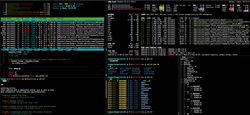Add Comments To Your Commands
A quick tip: when you write an important command in shell, put a comment next to it so you can easily find it later or remember what it does:
pytest -m slow --durations=10 # Run slow tests, return the slowestWhy?

I rely heavily on searching commands in history. Something like the guy above, but I usually press ctrl+r instead of ↑.
The problem with this approach is that sometimes it's not easy to figure out how to find a specific command. You have to know at least part of the command, which might be difficult if you copied it from somewhere and immediately forgot about it. Or maybe the part that you remember is too generic. If I want to rerun pytest with a specific set of parameters, I know it starts with pytest, but that doesn't really narrow it down.
So I started annotating commands I might want to reuse in the future. Let's say I want to run pytest on all the tests marked as "slow" and return the slowest ones. I can put a comment right next to the command:
pytest -m slow --durations=10 # Run slow tests, return the slowestThis will make it much easier to find this command in the future. It works especially well in combination with a fuzzy finder like the fzf:

A real-world example
I often use this trick in IPython when I want to find some example data in the system. In one of the projects I worked on, we had a database full of objects with numeric IDs. If I wanted to grab an object, I could either:
- Search in the UI for the ID of an object I want to retrieve from the DB. This takes time. I don't want to fire up the UI and do all the filtering to get the ID. So usually, I use the second approach.
- Grab a random object from the DB and hope it has the type I'm looking for. If not, grab a different one.
Sure, the second approach might take much longer than the first approach. But just like the guy pressing the arrow up 50 times, I kept thinking that "the next object has to be the right one."
I solved that problem by adding comments - each time I grabbed a specific object from the DB, I wrote a comment on what's that:
read_object("/Trade/98182379") # Trade X from "Portfolio A"
read_object("/Trade/18293712") # Trade Y from "Portfolio B"That way, the next time I wanted to grab an object from Portfolio A, I just needed to hit ctrl+r and type "Portfolio A".

